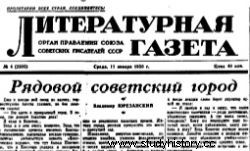After World War II, the French had an amazing love for the Soviet Union and communism. Until the 1970s, the French Communist Party was one of the main political forces on the Seine. In subsequent elections, it won from 20 to almost 30% of the votes. It was only a certain film and a certain book that made the French think ...
Everyone has heard about the book. This is the "Gulag Archipelago" by Alexander Solzhenitsyn (1973). Its publication already caused a storm in France. How is that? Soviets fighting for good, freedom and justice keep people in concentration camps ?! Only one thing was missing from Solzhenitsyn's story:a tangible, visual proof. This one came two years later.
In December 1975, the first French television channel aired a film advertised as a documentary shot in a Soviet concentration camp for political prisoners. Contrary to what one might expect, it was not a particularly moving or macabre image . Marc Ferro, author of the book "Cinema and History" described it as follows:
The movie is approximately eight minutes long. It is a silent, colorful film. A few "blank frames" in the middle of the document indicate breaks in filming. (...) It can be assumed that the film was shot (...) hidden.
Here we see in the document an edifice surrounded by barbed wire and a watchtower placed on top of something like a superstructure. Neither the tower nor the wall with wires is particularly overwhelming and high, everything seems quite ordinary. Militiamen or military men in green uniforms and epaulettes are on guard, dogs accompany them.

The camp shown in the film was located in more or less this setting of the outskirts of Riga. Unfortunately, we didn't manage to get to the frames from the document itself.
Suddenly, in the close vicinity of policemen, prisoners appear. There are about sixty of them (…). They walk in a row, at a normal pace, there is no sign of any strict discipline. However, the presence of dogs (...) proves that the supervision is close and constant (pp. 131-132) .
For Poles who knew perfectly well what their friends from the East were capable of, this film would probably not impress. After all, it was not a concentration camp. As Marc Ferro rightly pointed out, the film shows an ordinary penal colony, located right on the outskirts of Riga. It was in no way hidden or secret, and the rigor was no different from that of, for example, American prisons. The real Gulag, which Solzhenitsyn wrote about, looked incomparably worse.

The Soviet press immediately launched a counterattack ... The illustration shows the vignette of "Literaturna Gazeta".
But the French had so far been convinced that the USSR really was an advocate of world peace. Most of them blindly believed in the assurances that there were no political prisoners in the Soviet Union.
Of course, the Soviet media responded by attacking the attack. A journalist from "Literaturna Gazeta" wrote:
How disciplined these "free", "independent", and "liberal" criminals are! The most respected press, TV and radio companies launched the attack, as if on command!

The article is based mainly on the book by Marc Ferro entitled "Cinema and history" (Polish Scientific Publishers PWN, 2011).
Such a reaction and Soviet accusations of a lie sewn with thick threads they couldn't be liked. Even the French Communist Party felt the ground burning under her feet. After a few months, at a congress in 1976, the formation decided to sever its ties with the Soviet Union and oppose the dictatorship of the proletariat. One of the American newspapers reported:
Rather than repeating the [Soviet] allegations, the French Communist Party challenged Moscow, demanding that such camps exist and that political prisoners were sent there be denied. Moscow retorted:"There was a collusion between French communists and anti-Soviet forces."
Thus, this completely inconspicuous film shattered the faith of the French in communism. Admittedly, the French Communist Party distanced itself from him in time, but also suffered a ricochet. After 1981, she only passed the 10% threshold in the general election once.
